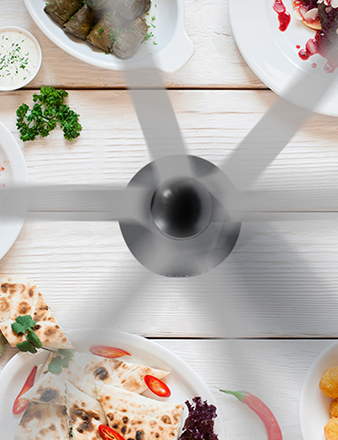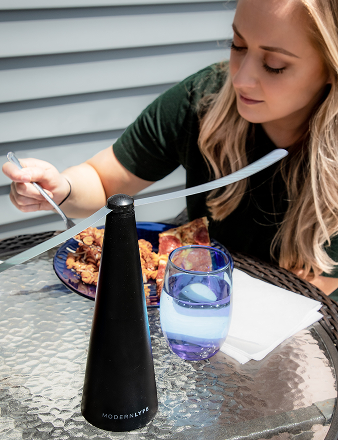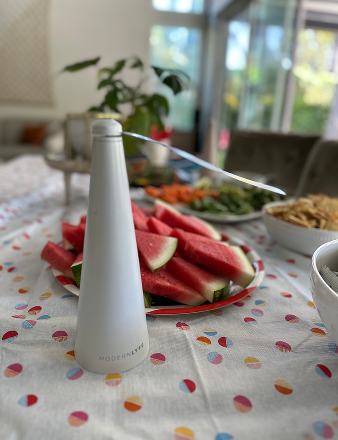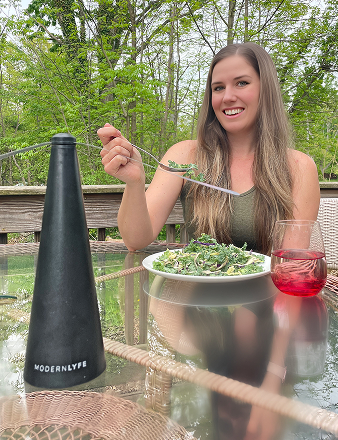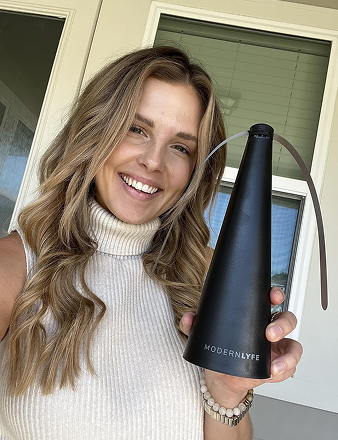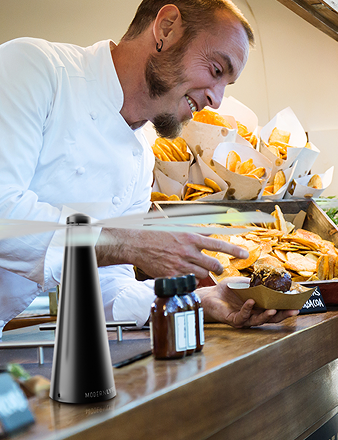Setting up a buffet table is more than just placing food on a surface. It's about creating an intuitive experience that guides guests effortlessly. The best setups are built on three core principles: logical flow, visual appeal, and food safety. This guide moves beyond the basics to show you how to create a buffet that is both beautiful and functional.
Crafting the Perfect Buffet Experience
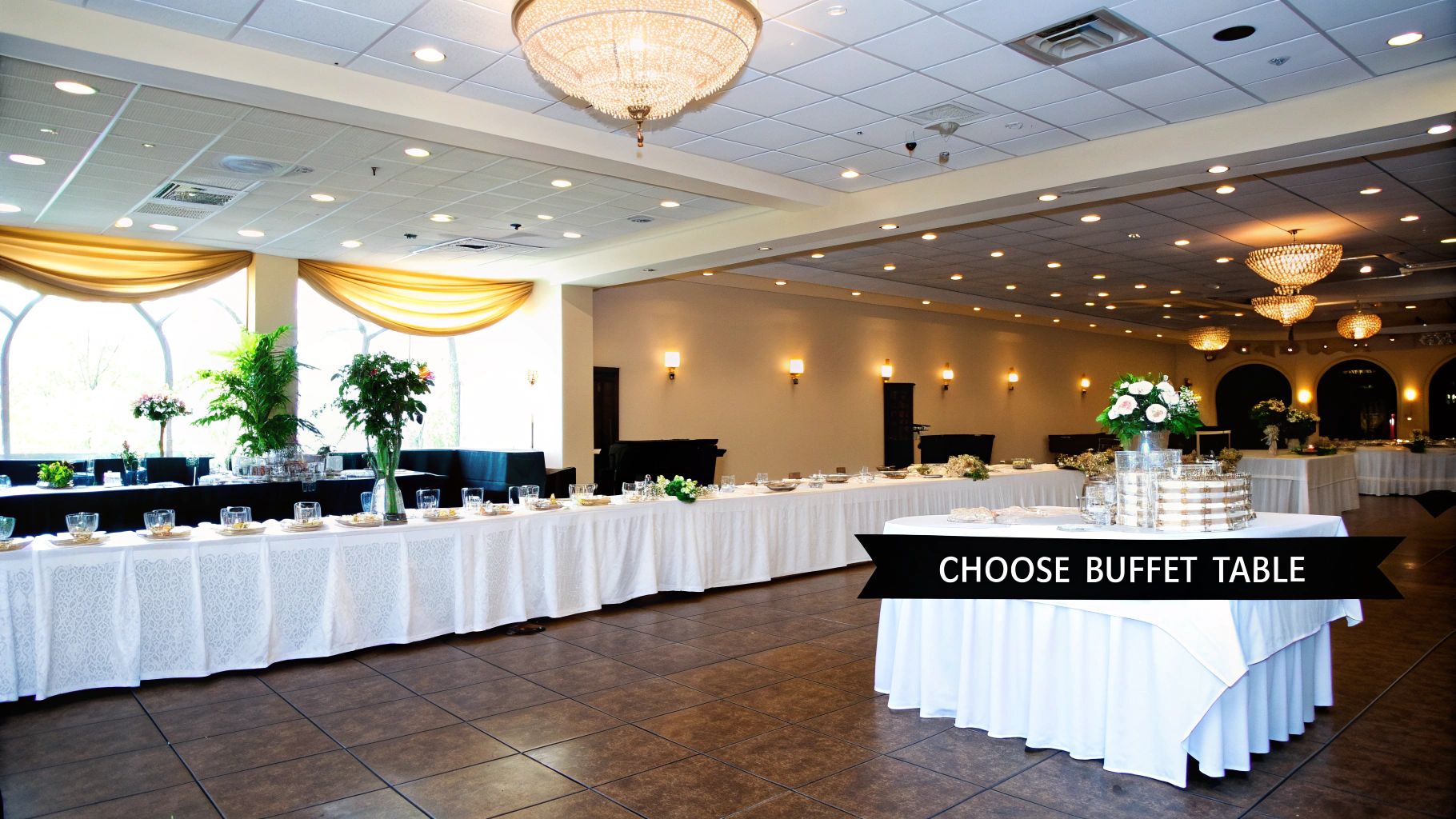
Think of your buffet layout as the silent host of your event. It directs traffic, showcases the menu, and ensures guests can serve themselves comfortably. The goal is to eliminate bottlenecks and disorganization, creating a seamless journey from plate to seat.
To achieve this, you must think like a guest. Where do they start? How can they move without congestion? What information do they need? Every detail, from table shape to platter height, contributes to the overall experience.
The Foundation of a Memorable Buffet
Before diving into specific techniques, understanding the fundamentals is key to a successful buffet. These are the building blocks for any event, from a corporate lunch to a backyard wedding.
Focus on these key considerations:
- Logical Guest Flow: Arrange tables and dishes to create an intuitive path and prevent traffic jams.
- Visual Presentation: Use height, color, and texture to build an appetizing display that excites guests.
- Practical Accessibility: Ensure every dish is easy to reach and serve without difficulty.
- Food Safety and Hygiene: Keep hot food hot and cold food cold. Provide clear labels for allergens and dietary restrictions.
The buffet style's popularity reflects a global preference for flexible dining. The global buffet table market was valued at $1.2 billion and is projected to reach $1.8 billion by 2033. In the U.S., nearly 75% of adults prefer restaurants with buffet options. You can explore more buffet market trends to see how consumer tastes are driving this growth.
A well-executed buffet is an experience, not just a meal. It's where thoughtful design meets culinary delight, leaving guests impressed with the seamless execution and incredible food.
Designing Your Buffet Layout for Seamless Flow
A successful buffet starts with its flow. Before placing a single dish, establish a solid floor plan. A strategic layout prevents frustrating bottlenecks and creates a relaxed atmosphere for your guests.
Your guest count and venue size will dictate the optimal setup. For smaller events, a single line of tables against a wall is a classic, effective choice. For larger crowds, this same setup will create a slow-moving queue.
This infographic outlines the core principles of a well-organized buffet line, guiding guests logically from start to finish.
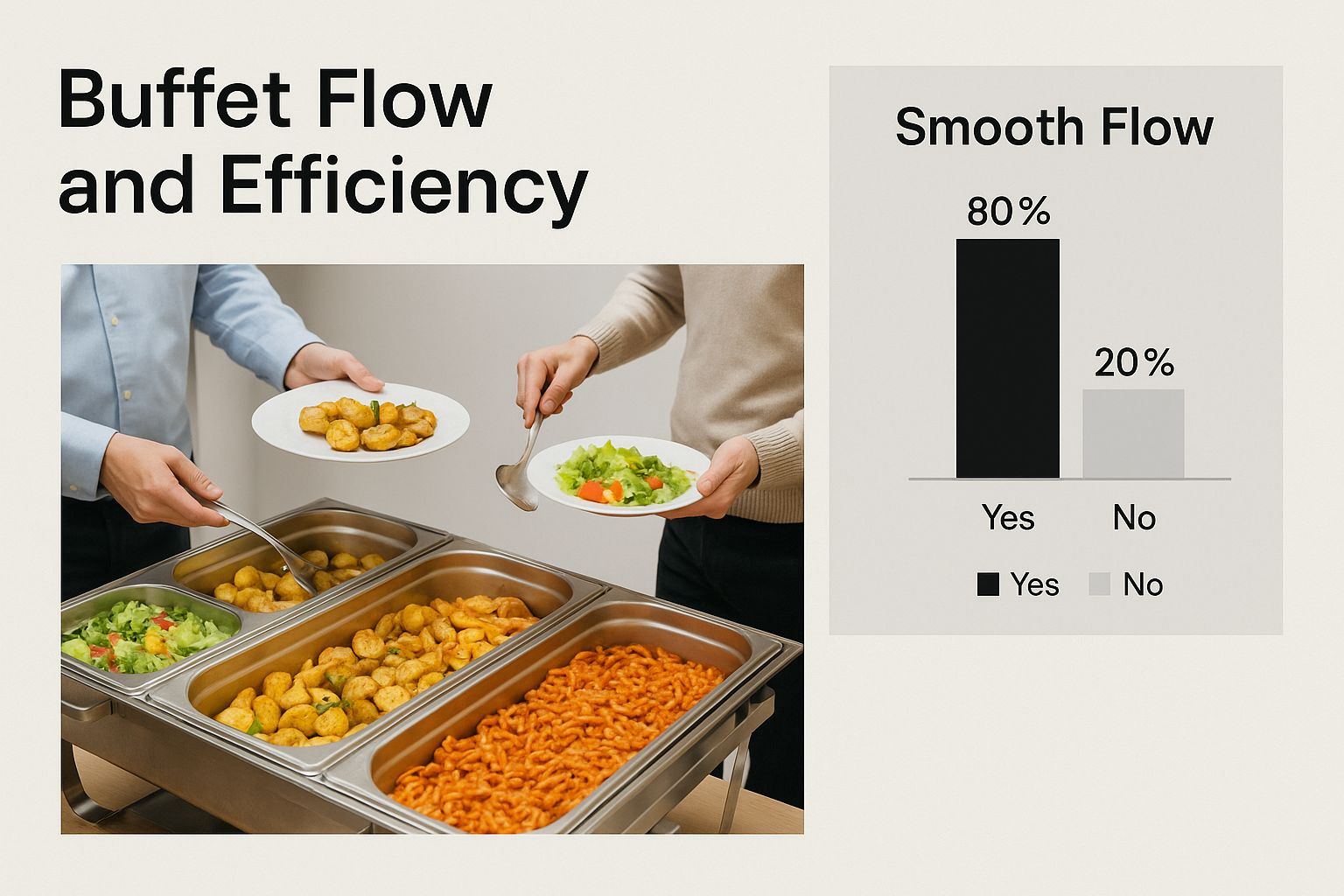
As shown, a logical food sequence is crucial. It keeps the line moving and ensures guests don't have to double back for items they missed.
Strategic Table Configurations
For 50 or more guests, it's time to get creative with your table configuration. A double-sided buffet is a game-changer, allowing two lines to form simultaneously and effectively cutting wait times in half.
Another excellent option is the U-shaped configuration. This setup creates a defined service zone and encourages a clear, one-way path for guests, minimizing confusion.
Consider a real-world scenario: a wedding reception in a compact venue. A double-sided table is the best choice to maximize the tight space. Now, picture a large corporate conference. Multiple, distinct food stations—a salad bar, a carving station, and a dessert table—are far more effective for managing a large crowd and maintaining flow.
To help you decide, here is a breakdown of common buffet layouts.
Choosing the Right Buffet Layout for Your Event
A quick comparison of common buffet configurations to match your guest count and venue.
| Layout Type | Best For | Pros | Cons |
|---|---|---|---|
| Single-Sided | Small, casual events (under 50 guests) | Simple to set up; uses minimal space | Quickly creates long queues with larger crowds |
| Double-Sided | Medium to large events (50+ guests) | Serves guests twice as fast; efficient | Requires a central space with access on both sides |
| U-Shaped | Medium-sized events with a defined space | Excellent traffic control; feels organized | Can feel enclosed; requires more tables and space |
| Food Stations | Large events, conferences, weddings | Disperses crowds; offers variety; high-end feel | Requires the most space and staffing; complex setup |
Ultimately, the best layout feels natural for your specific space and event style.
The goal is to make the journey from plate to seat as intuitive and effortless as possible. Your layout should silently guide your guests, not confuse them.
Guiding Guest Behavior
You can direct guest movement simply by the order in which you place items. People instinctively follow the path you create.
- Plates go first. This is the universal starting signal. Stack them at the beginning of the line.
- Drinks and silverware go last. This is a non-negotiable rule. Placing utensils and napkins at the end of the line frees up guests' hands to serve themselves without a clumsy balancing act. For an even better setup, create a separate beverage station away from the food to eliminate congestion entirely.
Arranging Food for Visual Appeal and Logic
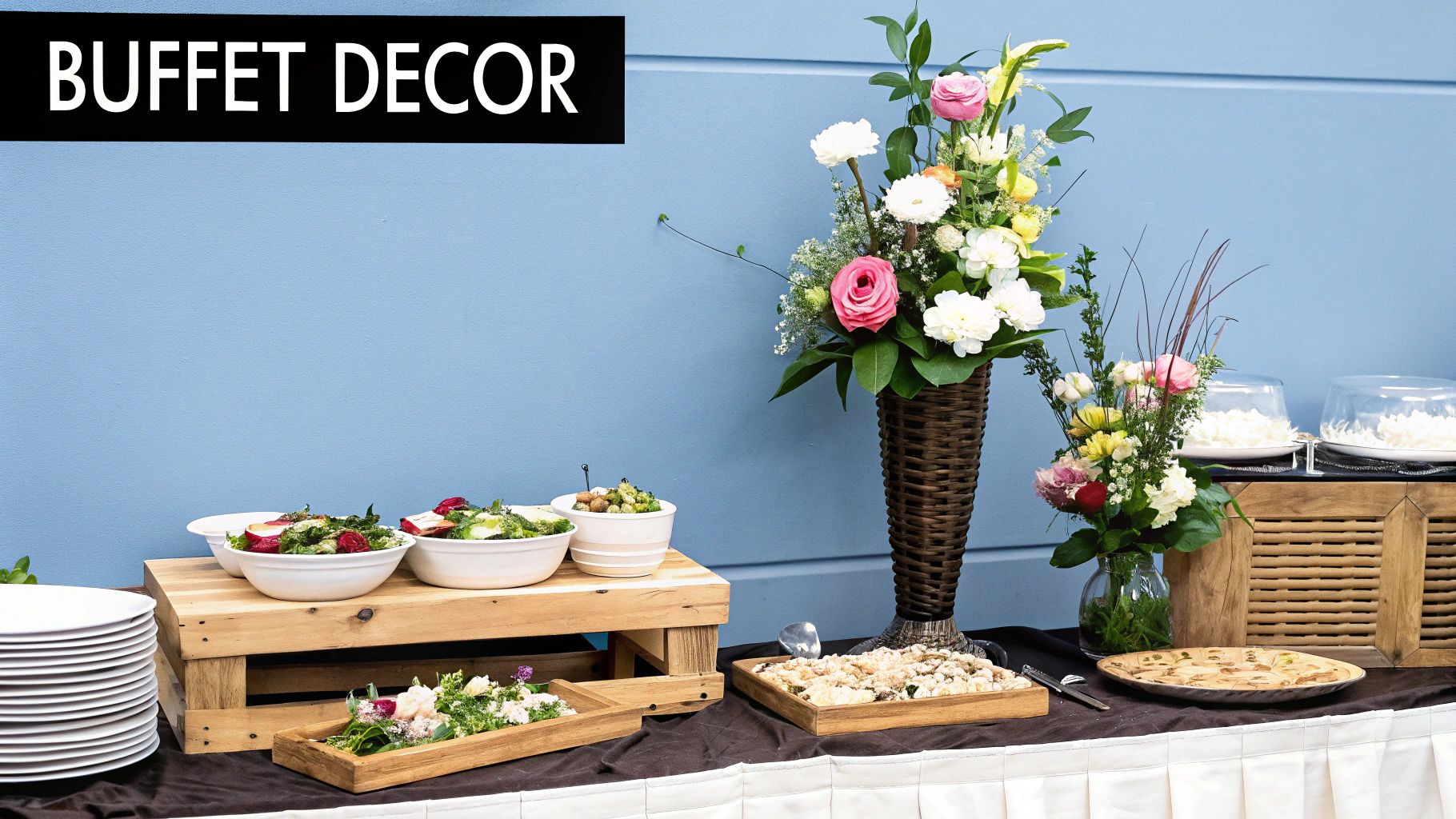
Once the table layout is set, it’s time to arrange the food. A well-designed buffet does more than hold dishes; it tells a culinary story and makes the food look as good as it tastes. The goal is an effortless and enticing experience.
The best method is the "first-to-last" principle used by professional caterers. Arrange food in the order it will be eaten. Start with plates, followed by salads, main courses, sides, and finally, desserts—preferably on a separate table.
Following this logical path prevents traffic jams and backtracking. It feels intuitive and natural.
Creating a Dynamic Tablescape
A flat buffet table is a missed opportunity. The key to a show-stopping display is to introduce varying heights. This single technique adds depth and visual interest, making your spread look professionally styled and more abundant.
You don't need a large budget to achieve this. Get creative with items on hand:
- Cake stands are perfect for elevating a signature dish or dessert.
- Sturdy bowls or wooden crates, when flipped over and covered with linen, become instant platforms.
- Stacking a few clean plates can give a platter a subtle lift.
Playing with height draws the eye across the table, ensuring every dish gets noticed and is easy to reach.
This move toward a modern, adaptable style is also reflected in home decor. Sales of traditional farmhouse-style buffets have dropped by 22% as consumers gravitate toward flexible and sustainable furniture. You can discover more insights about evolving furniture trends to see how this shift impacts home entertaining.
A well-arranged buffet is a feast for the eyes before it's a feast for the stomach. Varying heights and logical grouping turns a simple meal into an impressive culinary presentation.
Grouping Food for Clarity and Convenience
Organize dishes into logical groups to help your guests. Create distinct zones for different food types—all salads together, hot sides in one area, and so on.
This is especially critical for accommodating dietary restrictions. Always create a clearly labeled section for vegetarian, gluten-free, or nut-free options.
This simple step allows guests with specific needs to serve themselves confidently without asking questions. It is also the most effective way to prevent cross-contamination from shared serving utensils. It’s a small detail that makes a big impact.
Getting Temperature and Equipment Just Right
Maintaining proper food temperature is about more than taste—it's a critical component of food safety. The right equipment is what keeps hot dishes steaming and cold items fresh. Chafing dishes, chilled platters, and other tools are the unsung heroes of a great buffet.
For hot food, chafing dishes are the industry standard. Learning how to use a chafing dish for perfect buffet service is a fundamental skill. They provide gentle, steady heat that keeps food warm and appetizing for hours. Slow cookers and warming trays are also excellent for items like meatballs, soups, or sauces.
Pro Tip: Warming equipment is for holding temperature, not for cooking. Ensure every dish is fully cooked and heated through before it is placed on the buffet line.
Keeping Things Cool and Crisp
Cold dishes require equal attention. Nothing is less appealing than a wilted salad or lukewarm shrimp. The solution can be as simple as nesting a serving bowl inside a larger bowl filled with ice.
For a more polished setup, use chilled serving platters with built-in cooling packs or arrange trays over a bed of crushed ice. This keeps food looking and tasting fresh. While focusing on temperature, it's also important to guard against pests. We have a guide on how to keep your outdoor buffet pest-free with practical advice for any event.
The Magic of Live-Action Stations
To truly elevate the guest experience, add a live cooking station. A portable induction cooktop is all you need for a chef to prepare fresh pasta or sear scallops on the spot. This turns the meal into interactive entertainment and adds a high-end restaurant feel.
This trend toward dynamic, on-the-spot cooking is growing. The market for portable buffet ranges is projected to grow from $1.07 billion to over $2 billion by 2035, signaling a shift toward mobile, efficient, and memorable guest experiences.
Adding Polished Final Touches to Your Buffet
This is where you transform a simple food display into a high-end experience. The final touches are what guests notice—they add a layer of thoughtfulness that shows you've considered every detail. The goal is a cohesive, professional presentation.
Start with the foundation: linens and decor. Select tablecloths, runners, and napkins that align with your event's theme or color scheme. Small details like a tasteful centerpiece or seasonal accents can pull the entire setup together. Think of the decor as the stage for your menu.
Use elegant, clear food labels. This small gesture is incredibly helpful, especially for guests with dietary restrictions. Small chalkboards offer a rustic feel, while professionally printed cards are perfect for a formal affair.
Solving Common Buffet Problems Gracefully
Even the most well-planned buffet can encounter issues. For outdoor events, keeping pests away is a top priority. Instead of clunky fans, integrate sleek, blade-free fly fans. Placed strategically between dishes, they blend into the decor while keeping food protected.
Hygiene is another area where you can add a professional touch. To ensure everything stays clean, consider integrating sneeze guards. They provide a subtle, unobtrusive barrier that maintains a pristine look.
A truly polished buffet anticipates what guests need before they even have to ask. From clear labels to discreet pest control, these finishing touches show you’re committed to their comfort and create a completely seamless experience.
If you’re planning an outdoor event, extra preparation is essential. Find more ideas in our guide on essential accessories for a picnic, many of which are perfect for a buffet setting. This is how you ensure your event is remembered for all the right reasons.
Answering Your Top Buffet Setup Questions
Even experienced hosts encounter challenges when setting up a buffet. Here are answers to some of the most common questions.
How Much Food Do I Actually Need?
A good rule of thumb is to plan for 1 to 1.5 pounds of total food per adult. This breaks down to 6-8 ounces of protein and 4-6 ounces for each side dish.
However, you must know your audience. If you're hosting a sports team, plan for more. For a light afternoon event, you can aim lower. It's always a good idea to make extra of the most popular dishes—they are always the first to go.
What’s the Best Way to Handle Dietary Restrictions?
Clarity is essential. Use small, elegant labels for every dish, clearly stating common allergens or dietary notes like "Vegan," "Gluten-Free," or "Contains Nuts."
It's also a great practice to create a dedicated "safe zone" on the table. Grouping all gluten-free or nut-free options together makes it easier for guests to serve themselves without worry or risk of cross-contact.
The single most important step is to provide a dedicated serving utensil for every dish. This is a non-negotiable for preventing cross-contact. It is a cornerstone of learning how to prevent food contamination and shows guests you have prioritized their well-being.
How Can I Stop That Dreaded Buffet Line Backup?
A single, long food line is the primary cause of poor party flow, especially with more than 50 guests. The easiest solution is to make your main table double-sided. Allowing guests to serve from both sides instantly cuts the wait time in half.
For larger crowds, break the buffet into stations. This creates a more dynamic feel and prevents guests from clustering in one spot. Try this setup:
- A fresh salad bar on a separate table.
- The main hot dishes and a carving station as the centerpiece.
- A separate table for desserts and coffee.
This layout naturally disperses the crowd and encourages mingling. A final tip: always place drinks at the very end of the line or, even better, on a separate table.
A flawless buffet is about creating an effortless, enjoyable experience. Keep your beautiful spread looking its best and completely pest-free with the sleek, silent fly fans from Modern Lyfe. Shop our collection today and give your guests a perfect meal.

